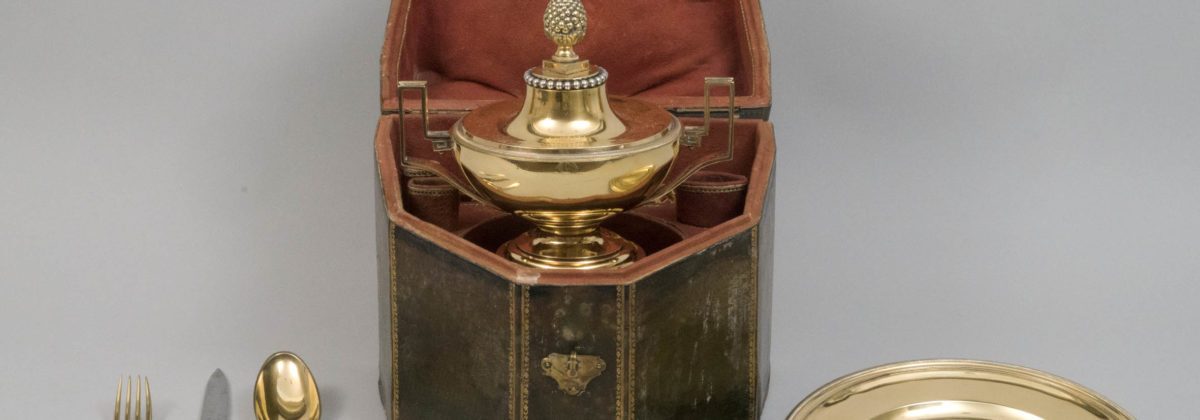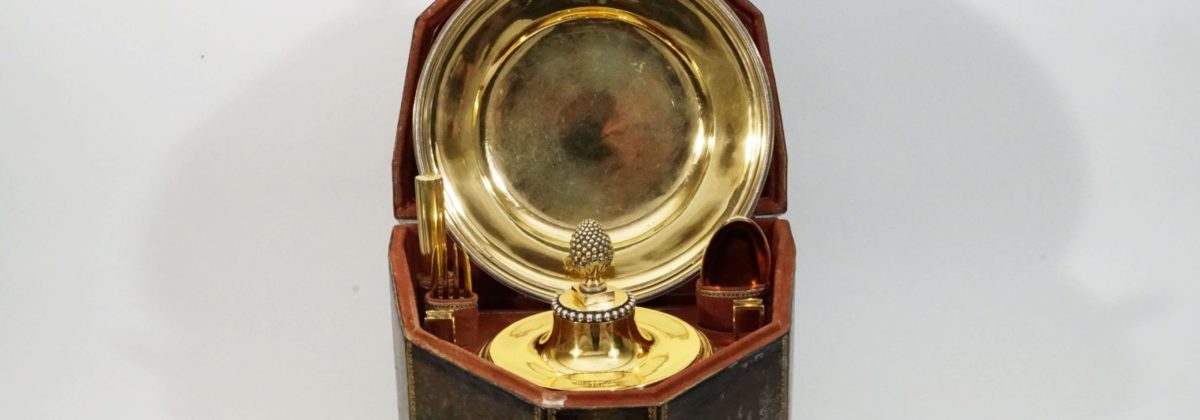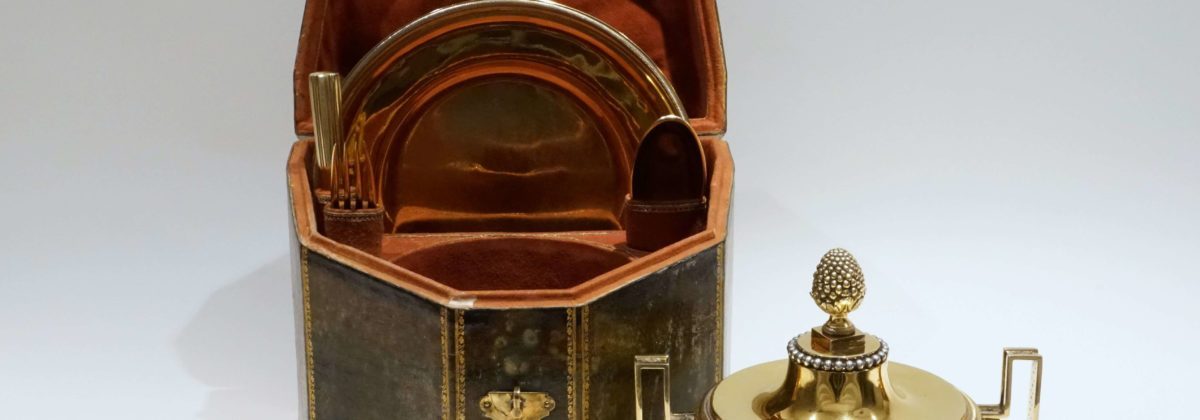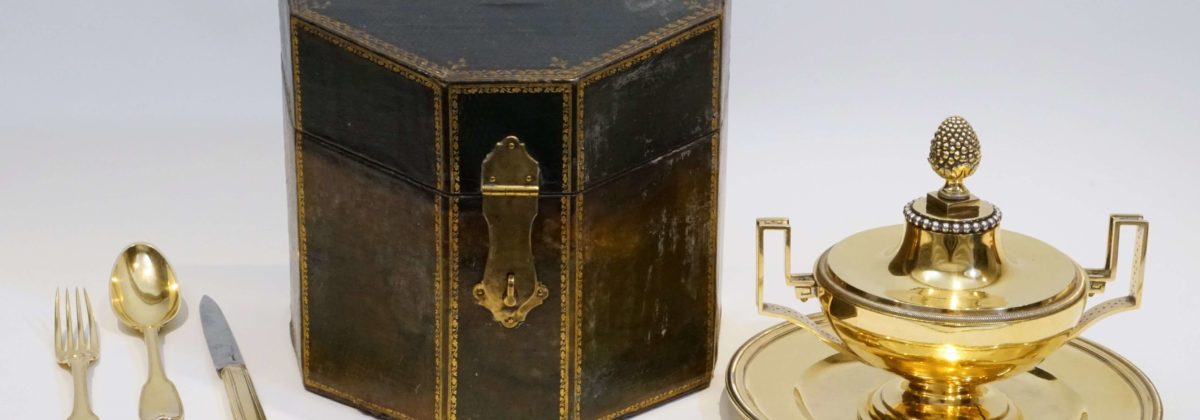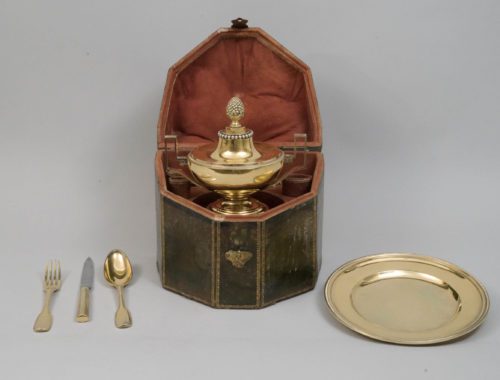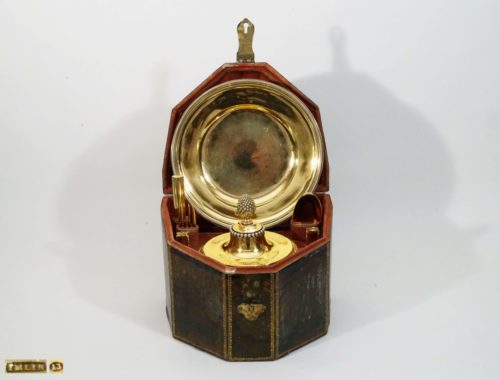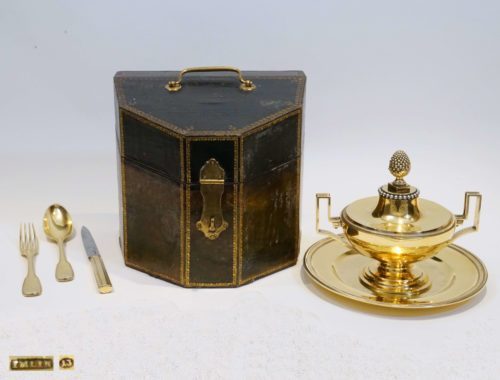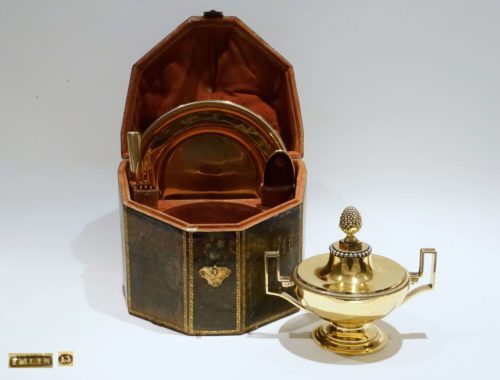Object Number: #194
Strasbourg c. 1790
François Daniel Imlin
City’s hallmark: “13” for Strasbourg, Period 1784-97
Makers’ marks: “IMLIN” in a rectangular shield for François Daniel Imlin (s. Exh. Cat.. Deux siècles d’orfèvrerie à Strasbourg, p. 301)
Weight: 1756 gr.; Case: H.: 24,5 (9,65 in.); W.: 27 (10,63 in.); D.: 20,5 cm (8,07 in.)
Detailed Information
French Travelling Nécessaire: Original Case and Vermeil Fittings
This French travelling nécessaire from the end of the eighteenth century has vermeil (silver-gilt) fittings. Thus, it is made of: a bowl with a cover, a dish with a broad edge, which serves as a display platter, a knife, a fork and a spoon. The parts are placed in an original wooden case, covered with leather and inside with tailored walls for receiving the objects. The marks are punched on all parts.
Both the objects and the case are designed in a strict, neoclassical style. The bowl has a similar form to an ancient vase and is raised on a high, vaulted and profiled foot. The body is oval and is left smooth. On this smooth corpus is placed a cover, which gives the object its charm. This cover is thus smooth and in the middle becomes bell-shaped. On the rim, there is a fine, engraved frieze of gadroons. The vaulted middle of the cover is decorated above with a ring of pearls and has as a finial a stylized, cast pine cone, which stands on a squared socle. On the sides there are two cast handles that gives the bowl a very fine finish. These are typical for an antique vase, that is square and decorated on the sides with meanders. The dish/display platter has a wide edge and its only décor is a fine, engraved gadroons frieze, just like by the bowl. The cutlery has a long stem, which is wide above and is decorated with an engraved line. The handle of the knife is silver-gilt and has engraved lines, while the iron blade can be unscrewed and has also a makers mark.
All five parts are placed in an original, hexagonal case made with intended, lined walls covered with red velvet. These are moreover decorated with golden laces, all kept in a perfect condition. The case closes with a brass fitting in the middle and has above a handle. The case presents a very qualitative work of leather art (maroquinerie). This green leather is decorated with punched golden flowers on the inside of every square side of the case.
Both the case and the objects are kept in a remarkably excellent condition. The gilding of Strasbourg demonstrates high-quality. Most probably, this is due to the fact that very often such cases and their content were mostly for showing, and they were offered as gifts. Such gifts of travelling cases with bowls and cutlery were presented according to French and German customs to young mothers on the birth of their first child (for the so called “bouillon d’accouchée”; in German the bowl is called Wöchnerinnenschüssel).
Travelling Nécessaire: An Object of the Seventeenth and Eighteenth Century
Travelling nécessaires are cases, which can be transported and contain the absolutely most necessary objects for the travel (the necessaries or “nécessaires”). They are being more and more frequently produced towards the end of the seventeenth century, but their wide diffusion becomes important during the eighteenth century.
Travelling cases have a long history, particularly in France. They are mentioned in written sources since the late fourteenth century (s. e.g. in Douët-D’Arcq (publ. pour la Société de l’histoire de France), Nouveau Récueil de Comptes de l’Argenterie des Rois de France, Paris: Librairie Renouard, 1874). In the sixteenth century, the King Francis I., great patron of the arts, possessed a travelling necessaire of an outstanding Quality.
Originally, one called “nécessaire de voyage“ objects that were made for taking coffee, tea and chocolate while on the road. Throughout the eighteenth century, these became much popular and were thus made for several uses: for writing, for eating, for the lady’s toilet, etc. The purpose of these travelling nécessaires is to be able to contain as much objects as possible in an as much small as possible space. Besides, they represent master works produced by several experts: cabinetmakers, goldsmiths, mirror and leather goods manufacturers. The aesthetic aspect of them has always been of great importance and this is why these objects were most often made by silver, silver gilded, gold and other precious materials.
Strasbourg and Its Silver Tradition
The history of silversmith in Strasbourg goes back to the fourteenth century. As Strasbourg was in 1681 integrated in France from Louis XIV (1638-1715), the makers had maintained their medieval guild organisation since the time of the free and imperial city and until the French Revolution.
The Thirty Years’ War had impoverished Alsace so that luxurious items were not that often for trading. However, since 1681 the new administrators of the city began to arrive (high officials, governors of provinces, German princes with property in Alsace), the catholic clergy and bishop returned back and so gold- and silversmiths could acquire again important orders for supplying enough luxurious objects to the new Patrons.
The mode in silver in Strasbourg was oriented to the “manières françaises” and not any more to the German goldsmith’s cities of Nuremberg and Augsburg. Since 1681, the makers of Strasbourg had the right to execute pieces of silver in the name of the king. These makers were besides conducting an excellent work and were after the Parisian makers very important. The goldsmiths in the city of Strasbourg belonged often to dynasties. For instance the Imlins were active as goldsmiths since the seventeenth century.
The silver-gilt objects from Strasbourg gained an international prominence. The quality and resistance to oxidation of the silver-gilt silverwares gave the Strasburg-vermeil a first place for the markets of warm and humid lands, specifically those of the remote French colonies, like Senegal. Besides there were no toll charges on the exported objects and this had as a consequence the ordering of objects from the German courts also, which had on the meantime adopted French fashion styles. All this contributed to the making of travelling nécessaires of excellent quality.
Maker
François Daniel Imlin (1757-1827) became a master maker in 1780. He was the son of Georges Frédéric Imlin and the father of Emmanuel Frédéric Imlin. François Daniel Imlin had made objects in fine, neoclassical style. See for instance two candlesticks made from him in the exhibition catalogue Deux siècles d’orfèvrerie à Strasbourg (nr. 96 and nr. 97). A bowl with cover made from François Daniel is also depicted there (nr. 42). The family of Imlins have made many travelling necessaires for noble customers. The objects were almost always silver-gilt (vermeil) and the cases contained various objects. See for instance the large silver service by Imlin made for the Landgrave of Hesse-Darmstadt in, Hessische Hausstiftung – Museum Schloß Fasanerie, Die Darmstädter Silberkammer: Werke alter Edelschmiedekunst, cat. of the exhibition from 07th July until 31st October 2007, p. 102-115.
Literature
Truman, Charles, ‘A St. Cloud Nécessaire de Voyage circa 1750’ in The Connoisseur, April 1980, vol. 203, Nr. 818, pp. 253-5.
Poole, Julia, ‘Princess Pauline Borghese’s Nécessaire de Voyage’ in The Connoisseur, Oct. 1978, vol. 199, pp. 107-113.
Wittmann, Otto, ‘A Great Lady’s Nécessaire de Voyage’ in Apollo, 1971, vol. XCIV, Nr. 114, pp. 145-9.
Levallet-Haug, Geneviève, ‘Gold- and Silverware at Strasbourg’ in Apollo, 1971, vol. XCIV, Nr. 114, 140-4.
Martin, É. & Pesneaud-Antheaume, A.-Cl., Deux siècles d’orfèvrerie à Strasbourg. XVIIIe-XIXe siècles dans les collections du musée des Arts décoratifs, Strasbourg : les musées de Strasbourg, 2004.
Hessische Hausstiftung – Museum Schloß Fasanerie, Die Darmstädter Silberkammer: Werke alter Edelschmiedekunst, Kat. zur Sonderausstellung vom 07.07. bis 31.10.2007, Michael Imhof Verlag, 2007.


